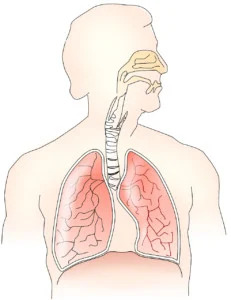Hyperventilation and incorrect breathing due to stress or burnout? Working hard, doing a lot of work and thereby functioning at high speed is not bad at all. As long as you, sufficiently and regularly, alternate this with catching your breath, both in the literal and figurative sense.
Breathing is so self-evident to all of us that we don’t realise how incredibly important and essential our breathing is. Stop breathing for 2 minutes, and you will immediately notice the vital importance of your breathing.
If you are constantly stuck in high gear, your breathing will also go into high gear even when sitting still or lying on a bed. When your body gets used to that, you can become ‘ill’. Exercise physiologist Stans van der Poel describes in her book ‘Chronische Vermoeidheid nooit meer!’ (Chronic Fatigue Never Again!) how long-term dysregulated breathing even leads to physical burnout, fibromyalgia, chronic fatigue or M.E.
Why do you breathe?
Every time we breathe, your lungs take oxygen out of the air and pass it on to your blood. The blood transports the oxygen to cells throughout the body that are going to provide energy again.
The more energy is requested (as in sport, stress) the higher the breathing in order to continue to provide the cells with oxygen.

How does breathing in work?
Inhalation works actively, i.e. an action takes place to breathe. The diaphragm contracts, the chest cavity becomes longer and wider and the lungs are filled with air. The intermediate rib muscles and chest help with this process. All muscles are in contact with the brain through nerves to control breathing.
After inhalation, air passes through the lungs along the bronchi (where air is purified) to the alveoli. These alveoli then release the oxygen to the blood. The alveoli also absorb the waste gas (carbon dioxide) from the blood so that it can be exhaled.
How does exhaling work?
Exhalation is passive: that means there is no muscle exertion involved. It’s a matter of letting air escape. (see also the picture).
How many breaths per minute is normal?
A little tension or stress can be helpful, but prolonged stress can be harmful. However, there are simple ways to deal with stress: Just calmly breathe in and out. So ask yourself: How many times do you breathe per minute? Have you counted your exhalations for a few minutes? Did you breathe more than ten times a minute? More than fifteen times?
As humans, we breathe on average between 8,000 and 29,000 times a day. If we’re breathing, we might as well do it in a good way, right? A healthy breathing pattern means breathing around 8 times a minute. If you do this more often, you may have chronic hyperventilation. Breathing exercises may be an option, but it is often better to find out the cause: This is often the cause of your stress.
Breathing during rest
Try counting the number of breaths per minute (an inhalation + exhalation counts for 1) while resting. If you count more than 15 breaths per minute, there is work to do in any case.
Your breathing doesn’t just give you information about the ‘acceleration’ your body is apparently in. That same breathing is also the ideal way to ‘downshift’. By lowering your breathing rate and prolonging your exhalation (preferably with a short pause after exhalation) you can put yourself in a lower gear in a surprisingly short time. With your own breathing, you always and everywhere have a very powerful tool at hand to help you relax.

The influence of stress on breathing
In case of stress, your body prepares to respond very quickly. This requires oxygen, a lot of oxygen. Your heart pumps like crazy to get rid of your toxins as quickly as possible and supply your muscles with oxygenated blood, so you can deliver maximum strength.
But the moment you are in a continuous state of fight or flight (a chronic stress situation) that leads to a chronic form of stress, it can lead to hyperventilation due to stress, but also:
- Dysfunctional breathing pattern
- Disruption of your breathing, even voice problems
- Panic attacks
Breathing incorrectly due to stress
When we inhale, we bring air containing a lot of oxygen into the body, and when we exhale, we blow out air that is rich in carbon dioxide. When breathing incorrectly, we change the air too often and therefore lose too much carbon dioxide. A shortage of carbon dioxide causes physical complaints such as:
- Shortness of breath
- Pressure on the chest
- Feeling rushed
- Heart palpitations
- Sweating excessively
- Dizziness
Your breathing style can tell you a lot about which gear you’re in right now. How does that work? When you are nervous about something or worry about something, your body reacts to it. You will notice this by an increase in your heart rate, blood pressure and an increase in your breathing.
Structural energy leakage
You then breathe relatively more with your chest and with too high frequency. This way of breathing is very useful when you have to take action (fight or flight) because then more oxygen has to be absorbed and more carbon dioxide emitted. But if you also observe that kind of breathing at rest, then it is important to do something about it, to prevent this disordered breathing from becoming a structural energy leak.
Hyperventilation due to stress
Our breathing happens ‘autonomously’. This means that it is controlled automatically. You don’t have to think about breathing. Fortunately, otherwise, your night’s sleep would look very different.
If you don’t think about your breathing, the respiratory centre in your brain takes control. The centre pays attention to the acidity in the blood and also the amount of oxygen in the blood.
Negative vicious circle
Stress, anxiety and depressive feelings stimulate the respiratory center. This causes you to breathe incorrectly (through the chest). Then the amount of carbon dioxide in your blood drops. Subsequently, the muscle tissue around the airways, intestines, arteries and stomach will contract, causing stress complaints.
These feelings cause you more stress, make you anxious and make you depressed, completing the circle again (see also the image below). Thus good breathing is crucial for the well-being of both your mind and your body. Stop stress!

The influence of stress on hyperventilation
The respiratory centre is under the influence of stress and emotions. When you are stressed, you sigh a lot. If you’re scared or anxious, you hold your breath. Once recovered from the shock, you sigh. In severe stress, anxiety, or emotional events, the respiratory centre is stimulated, causing your breathing to accelerate. Likewise, your breathing slows down the moment your stressors are removed again.
During chronic stress, your body gets used to this increased breathing, and the breathing can take on a life of its own. The respiratory centre gets used to the lower carbon dioxide content, becomes disordered and eventually ends up in hyperventilation. Ultimately, this leads to chronic hyperventilation.
Chronic hyperventilation
Chronic hyperventilation: where does it come from? Sometimes it is difficult to determine a cause. Chronic hyperventilation can have many causes. Sometimes the underlying problem is a lung problem, such as COPD, but often it stems from stress or other psychological problems. When you are stressed, your body ends up in a fight or flight mode. In this mode, you are going to breathe faster to pump enough oxygen into your blood. This way, you can act quickly to tackle the cause of your stress or run away from it.
However, if you continuously feel stress for an extended period, it can disrupt your breathing without you noticing. This sometimes makes it difficult to recognise chronic hyperventilation. There are so many symptoms that can be associated with this. However, many symptoms can also have a different cause. Also, some people suffer from a few symptoms, while others experience almost all symptoms. Because of this, a diagnosis can sometimes be difficult to make.
Chronic hyperventilation?
Symptoms of chronic hyperventilation
You lose too much carbon dioxide because you are breathing too fast. The carbon dioxide level in your body drops, and you get too much oxygen. This problem has a long list of possible symptoms.
Common symtoms are:
- Dizziness,
- Chest tightness,
- Tingly feeling around the mouth or in the fingers
- A feeling of restlessness and anxiety.
- Excessive sweating,
- A stuffy feeling,
- Shortness of breath
- Dry mouth
- Sore throat
- Hoarseness
These problems arise because patients often inhale through their mouth, where you normally inhale through your nose. As a result, the mucous membranes in your throat can dry out, causing difficulty in swallowing and causing a sore throat. The above symptoms may seem self-explanatory and are common, but the list of possible symptoms is a lot longer.

Physical symptoms of chronic hyperventilation
For example, people with chronic hyperventilation may experience:
- Cold chills while the environment is warm.
- A continuous difference in body temperature
- A flu-like feeling.
- Abdominal bloating: Irregular breathing allows air to enter the stomach, causing an uncomfortable feeling.
Chronic hyperventilation can also be the culprit of a variety of muscle issues.
- A sore back,
- Neck and/or shoulder issues
- Experiencing a weak feeling in, for example, your legs or arms.
- Dizziness
- Feeling like they are going to faint, or actually fainting.
- A stabbing headache
- (part of) the face becomes numb.
- Disorientation,
- Seeing black spots,
- Impaired vision
- Hearing loss
Hyperventilating during burnout
Burnout is a condition in which the body has taken control in order to recover. A completely exhausted feeling is the result. The body is in a survival mode. Torn between fight or flight.
In the old days, such a mode was meant to run away very fast or to fight. This (of course) requires a lot of oxygen.
In a normal stress response, the diaphragm strains to quickly supply a lot of oxygen and then relaxes again. This relaxation releases the waste and reduces the diaphragm.
When stress becomes chronic (prior to burnout), the diaphragm no longer relaxes, resulting in incorrect, shallow breathing, or hyperventilation.
Hyperventilation: How do you get rid of it?
Step 1 is to ensure correct breathing: Countless thick books have been written about breathing, but broadly speaking it boils down to this:
- Abdominal breathing is the healthiest.
- An adult takes approximately 8-12 breaths per minute (athletes 6-10 breaths)
- Taking a breath is effortless, and you don’t have to think about it
- Breathing should be smooth, without sighing or tightening.
Lowering stress with breathing
A study of long-term stressed-out mothers of children with attention or behavioural problems was done to test whether stress management is possible through breathing. During the research phase, the mothers learned the best way to breathe.
They were taught a regular, slow breathing rhythm. After two hours of training, with 30 seconds of practice every day (for 2 weeks), it appeared to be sufficient for stress reduction in the areas of heart, brain activity, breathing and emotions. Rapid breathing can therefore be a good indicator of stress.
If you breathe too fast in rest mode, you risk health problems such as hyperventilation, panic attacks and even burnout or depression. Consciously breathing slowly and (calmly) exercising provides relaxation. People with stress and burnout complaints need to learn to relax. Breathing is an important tool in this.

Heart coherence
One method based on relaxation through breathing exercises is heart coherence. This method allows you to influence your heart rhythm by regulating your breathing. This will calm your autonomic nervous system, also in your hormonal system, in particular, the production of too much “negative” cortisol will be reduced. The ideal rhythm, in which heart rate and breathing work together optimally, is a ten-second cycle, breathing six times per minute at rest. So what can you do in a stressful situation? Breathe a little deeper and a little slower than usual. It really is that simple.
Abdominal breathing
While some are sceptical, others swear by breathing exercises to regain control of breathing. The first step is to measure how often you breathe in and out per minute. Set your timer to 1 minute, take a pen and paper and make sure you are at rest. Each time you inhale, you draw an ascending line and when you exhale, you draw a descending line.
Do you have more than 15 lines on paper after a minute? Then it is time to change that. The second step is to extend your exhalation. When you feel like you’re going to breathe in, wait two or three seconds. Then breathe as you normally would. If you did this throughout the day, you would, of course, exhaust yourself completely with conscious breathing. So take some time to practice this.
Breathing exercise: three times a day
For example, start by taking three minutes, three times a day, every day, to do this breathing exercise. When breathing, it is important to “breathe” with your abdomen. This means that your tummy goes up and down when you breathe, without your chest rising.
When your breathing is rapid you will quickly feel dizzy, but abdominal breathing can make you calmer, and any back pain you may have as a result of the chronic hyperventilation will most likely also decrease quickly. A good tip is to think about soothing things during these breathing exercises. Think about what you’re grateful for in your life or reminisce about it. This way, you can change your mind for a while away from deadlines, problems and fears.

Why do you need to exhale longer?
Simply put, inhaling activates the sympathetic part of your autonomic nervous system – i.e. the accelerator. Exhaling activates the parasympathetic part of your autonomic nervous system – the brake.
You can check this instant effect by feeling your pulse (heartbeat) and discovering that your heartbeat is a little faster when you inhale and that it slows down a bit when you exhale. This phenomenon is called Respiratory sinus arrhythmia. Exhaling longer means more braking than accelerating.
Advantages of breathing correctly
- Recovery: You recover faster. By breathing better, your heart rate decreases, causing your body to relax. Because of this rest, your body recovers faster and better from exertion (mental/physical)
- Sleep: You sleep better. By doing breathing exercises you become calmer, thoughts turn off, sleep turns on.
- Performance in sports: You can move better. If your breathing is too fast you are quickly exhausted.
- Focus better: Do your thoughts regularly drift away completely? Do breathing exercises for 2 minutes, and you will see that your focus will return.
- Losing weight. You will lose weight. By breathing properly, you use energy-efficient fats as fuel.
Note: Are breathing exercises not working against hyperventilation? Then start working on the underlying factors!
Which breathing exercise?
It is important that during a breathing exercise you breathe using your abdomen. This means that your tummy expands instead of your chest.
A common exercise is:
- Inhale (3 seconds)
- Pause (1 second)
- Exhale (4 seconds)
- Pause (1 second)
Do not pause for so long that you’re gasping for air, but just enough to feel the urge to breathe again. You can wear a heart rate monitor to check whether your breathing exercise has an effect. If you do it right, your heart rate will drop by 5 – 10 beats per minute.
Breathing exercise for chronic hyperventilation
Tips for breathing exercises
- Find a quiet place
- Do breathing exercises 3 times a day, for 5 minutes, but take 15 minutes in the morning and evening during stressful periods.
- Visualise a pleasant thought (a nice vacation, for example) this helps to control your breathing (your body then produces more DHEA hormone)
TIP: Get started on a more stress-free life. Breathing incorrectly is a result of stress!
Sports and breathing
Once you have mastered quiet breathing, you can also learn to apply it during exercising. A lot of people do not exercise much or are too fanatical. This way, you could deplete your entire energy supply in your muscles during workouts. There is also a high risk of injury. It takes almost a week for those to recover, and then they repeat another training just like it. This only reduces the condition.
Therefore, it is important to find a balance. Not only with training and sports but also when using your breathing. Your breathing and heart rate will increase during training. When you are done training, give your body the chance to recover. By using breathing exercises after exercise, not only your breathing but also your heart rate and your autonomic nervous system will unwind.
Getting rid of hyperventilation
If your car has a flat tyre every week, you wouldn’t keep replacing it either. Eventually, you would look for the cause. It may be useful to leave fewer nails lying around in the garage.
It is the same with breathing. When you are constantly breathing incorrectly, you can get it under control with good exercises, but you must search for the cause of your incorrect breathing. So look at how your life is structured and at your bulging schedule!

About Milltain
Milltain supports, with a team of experienced trainers, organizations in the prevention of stress and the (re) finding of work happiness in the workplace. Our training courses are aimed at managers within companies. A burnout quickly costs the organization € 70,000.
In addition to financial suffering, human suffering is great. Not only for the employee but also for close colleagues who have to deal with the blows. Before you know it you are in a negative vicious circle.
Do you want an effective approach to long-term absenteeism and increasing work pleasure? (instead of extinguishing continuous fires).






